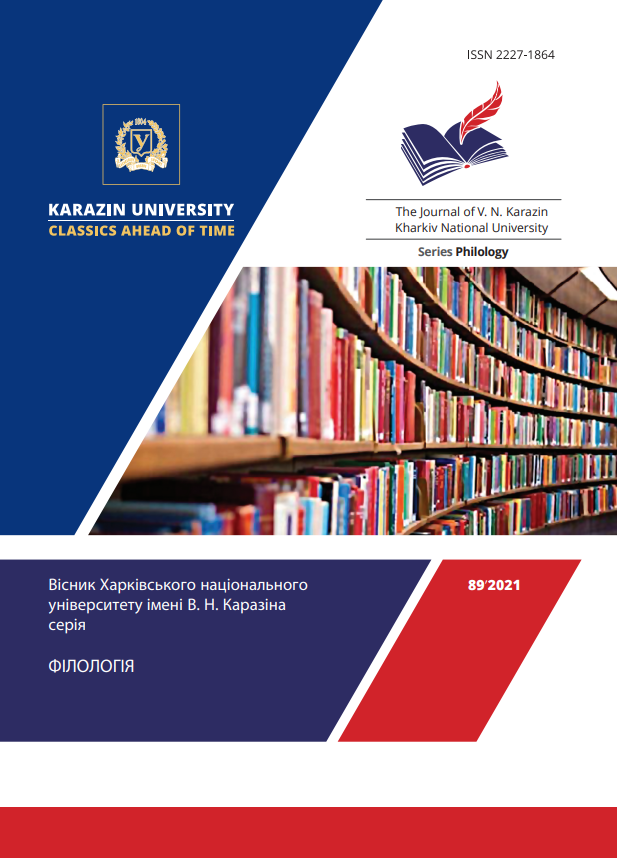On the intermediality of the Lesya Ukrainka essay "Loud strings"
Abstract
Intermediate approach allows to comprehend the text of Lesya Ukrainka's essay "Loud strings" as an original experiment. The novelty of the research lies in considering the composition of the essay as a sonata form (sonata allegro). As in the sonata form, "Loud Strings" can be divided into three parts – exposition, development and reprise. Moreover, the exposition is preceded by an introduction that allows the writer to reveal the main features of the portrait and character of the main heroin, Nastya Gritsenko. In the exposition of the essay, as in the sonata form, four parts are clearly presented: the "main", associated with music, as indicated by the title of the work, and the busts of Beethoven and Chopin in Nastya's house, the "connecting" in which the name of Paul's beloved appears, brother Nastya, "side", which is based on the motive of the letter received by the girl from Bogdan, and "final", in which Paul's love for Olesya is revealed.
As in the development of the sonata form, a short introductory section can be distinguished in the essay, the development itself and the background. Moreover, in the first sections, the motive of the letter of the "side" party dominates, either forcing Nastya to listen to the voice of her love for Bogdan, or evoking memories of meetings with him from the very beginning. In addition, in the development Lesya Ukrainka actively refers to allusions and reminiscences, inviting the reader to "recall" a wide range of works of world classical literature and music. Such intertext allows the writer to reveal Nastya's rich spiritual world.
In the reprise, the leading role is played by the "connecting" and "main" parts, based respectively on the performance of Olesya's "Desires" by Chopin and Nastya – the third movement of Beethoven's sonata No. 17, since the "side" part has completely exhausted itself in development. To reveal the complex range of feelings Nastya Lesya Ukrainka turns to musical ecphrasis. The last lines of the essay can be interpreted both as the complete collapse of the heroine's hopes, and as the catharsis she is experiencing. At the same time, the happy Paul is not able to help his sister. Obviously, the philosophical conclusion of Lesya Ukrainka herself emerges through the "final" game – life is filled with dialectical contradictions.
In general, the essay can be viewed as a neo-mythological text, in which the writer skillfully plays with “various traditions” (Z. Mints).
Downloads
References
Bazhannia (Shopen, Vitvitskyi-Iakovchuk). [Desire (Chopin, Vitvitsky-Yakovchuk)]. Retrieved from https://uk.wikisource.org/wiki/Бажання_(Шопен,Вітвіцький-Яковчук) (2021, March, 30)
Geller L. (2002). Voskreshenie ponyatiya, ili Slovo ob ekfrasise [Resurrection of the concept, or the Word about ecphrasis]. Ekfrasis v russkoy literature, sbornik trudov Lozannskogo simpoziuma. [Ecphrasis in Russian Literature: Proceedings of the Lausanne Symposium]. Moscow: MiK.
Hozenpud A. (1940). Operna dramaturhiia Chaikovskoho: narysy [Tchaikovsky's opera drama: essays]. Kyiv: Derzhavne vydavnytstvo «Mystetstvo».
Holovii O. (2016). Proza Lesi Ukrainky yak laboratoriia styliu [Lesya Ukrainka's prose as a laboratory of style]. – Volyn filolohichna: tekst i konteks, 22, 38-51.
Goncharov I.A. Luchshe pozdno, chem nikogda (Kriticheskie zametki) [Better late than never (Critical notes)]. Retrieved from https://librebook.me/luchshe_pozdno__chem_nikogda__kriticheskie_zametki_ (2021, March, 30)
Kotsura V.P. (Ed.) (2015). Entsyklopedychnyi slovnyk symvoliv kultury Ukrainy [Encyclopedic dictionary of Ukraine culture symbols]. Korsun-Shevchenkivskyi: FOP Havryshenko V.M.
Kalitskiy V.V. (2019). Kontsertmeysterskoe iskusstvo pianista [Concertmaster pianist art]. (Doctor’s thesis). Russian State Specialized Academy of Arts. Moscow.
Kirillina L.V. (2009). Betkhoven. Zhizn i tvorchestvo [Beethoven. Life and art]: v 2 t. Moscow: Nauchno-izdatelskiy tsentr «Moskovskaya konservatoriya». Vol. 1.
Kyryliuk S.D. (2018). Proza Lesi Ukrainky: v «antraktakh» mizh poeziieiu i dramoiu [The prose by Lesya Ukrainka: in the “Intermissions” between Poetry and Drama]. – Pytannia literaturoznavstva, 97, 7–22.
Landyshi: legendy i simvolika [Lilies of the valley: legends and symbols]. Floribunda: cvety i zhizn'. Retrieved from https://floribunda.ru/?a=382 (2021, March, 30)
Mahov A.E. (2001). «Muzykal'noe» kak literaturovedcheskaya problema ["Musical" as a literary problem]. Retrieved from https://cyberleninka.ru/article/n/muzykalnoe-kak-literaturovedcheskaya-problema (2021, May, 23)
Mints Z.G. (1979). O nekotorykh «neomifologicheskikh» tekstakh v tvorchestve russkikh simvolistov [About some "neo-mythological" texts in the works of Russian Symbolists]. – Uchenye zapiski Tartuskogo universiteta, 459, 76–120. Retrieved from http://www.ruthenia.ru/mints/papers/neomifologich.html
Musset A. de Lyubovyu ne shutyat [No Trifling with Love]. Retrieved from https://sufler.su/katalog/m/альфред-де-мюссе-alfred-de-musset/мюссе-а-де-любовью-не-шутят/ (2021, March, 30)
Roshal V.M. (2003). Polnaya entsiklopediya simvolov [The complete encyclopedia of symbols]. Moscow: Izd-vo Eksmo; St. Petersburg: Sova.
Pushkin A.S. (1960). Sobranie sochineniy [Collected works]: v 10 t. Moscow: Gosudarstvennoe izdatelstvo khudozhestvennoy literatury. Vol. 4.
Siruk V. (2016). Naratyvna struktura narysu Lesi Ukrainky «Holosni struny» [Narrative structure of Lesya Ukrainka's essay "Loud Strings"]. – Ukrainske literaturoznavstvo, 81, 153–162.
Sonatnaya forma [Sonata form]. Muzykalnaya entsiklopediya. Retrieved from http://www.musenc.ru/html/s/sonatna8-forma.html (2021, March, 30)
Tishunina N.V. (2001). Metodologiya intermedial'nogo analiza v svete mezhdisciplinarnyh issledovanij [Methodology of intermediate analysis in the light of interdisciplinary research]. Retrieved from http://anthropology.ru/ru/text/tishunina-nv/metodologiya-intermedialnogo-analiza-v-svete-mezhdisciplinarnyh-issledovaniy (2021, May, 23)
Ukrainka Lesya. Holosni struny. [Loud Strings]. Entsyklopediia zhyttia i tvorchosti. Retrieved from https://www.l-ukrainka.name/uk/Prose/GolosniStruny.html (2021, March, 30)
Faryno Ye. (2004).Vvedenie v literaturovedenie: uchebnoe posobie [Introduction to literary studies: schoolbook]. St. Petersburg: Izd-vo RGPU im. A.I. Gertsena.
Chigareva E.I. (2014). Muzykal'naya kategoriya motiva v organizacii literaturnogo proizvedeniya [The musical category of the motive in the organization of a literary work]. – Zhurnal Obshchestva teorii muzyki, 4А (8А), 8–14.
Chukantsova V.O. (2011). Problema intermedialnosti v povestvovatelnoy proze Oskara Uaylda [The problem of intermediality in Oscar Wilde’s narrative prose]. (Extended abstract of candidate’s thesis). Russian State Pedagogical University named after A.I. Herzen. St. Petersburg.
Shiller F. (1936). Kovarstvo i lyubov: meshchanskaya tragediya v pyati deystviyakh [Cabal and Love: bourgeois tragedy in five acts]. Moscow: Gosudarstvennoe izdatelstvo khudozhestvennoy literatury.
Shuman R. (1975). O muzyke i muzykantah: sobranie statej v 2 t. Moscow: Muzyka. Vol. 1.
Shchukina I. (2016). «Holosni struny» Lesi Ukrainky: muzyka v riadkakh i mizh nymy. [“Loud Strings” by Lesya Ukrainka: Music in Rows and between Them]. – Slovo i chas, 12, 10–17.
Horniatko-Szumilowicz Anna (2018). Holosni struny Lesi Ukrainky y melankholiinyi vals Olhy Kobylianskoi: khudozhno-typolohichni paraleli. Roczniki humanistyczne, tom LXVI, zeszyt 7, 55–74.




